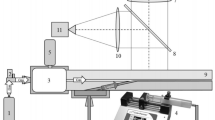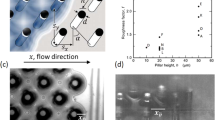Abstract
The existing methods for predicting/modeling the permeability of a wick structure involve the use of a capillary pressure model. Thus, the validity of the existing permeability models has not been verified independent of the capillary pressure. Here, for the first time, the permeability and capillary pressure of monoporous wick structures have been independently determined using a new experimental approach. In the new approach, the liquid mass flow rate against gravity is measured by testing the wick at its dryout threshold at different wicking lengths. The permeability and capillary pressure of the wick are then uniquely determined by curve fitting the wicking length-dependent mass flow data. The advantage of the developed method over Washburn’s rate of rise technique is that the current method yields both capillary pressure and permeability values while the former only returns the product of the two parameters. The permeability values obtained from the experiments were used to examine the accuracy of the existing permeability models.







Similar content being viewed by others
Abbreviations
- A :
-
Cross-sectional area of wick (m2)
- A m :
-
Area of liquid meniscus (m2)
- d :
-
Diameter of pillar (m)
- g :
-
Acceleration due to gravity (m/s2)
- H :
-
Height of pillar (m)
- H eff :
-
Height of liquid from pillar base to meniscus (m)
- h fg :
-
Latent heat of vaporization (kJ/kg)
- K :
-
Permeability (m2)
- L :
-
Wicking length—distance between top of evaporator and top of liquid pool (m)
- ṁ :
-
Mass flow rate (kg/s)
- p :
-
Pitch (m)
- P cap :
-
Capillary pressure (N/m2)
- r :
-
Pillar radius (m)
- s :
-
Solid volume fraction
- w :
-
Edge-to-edge pillar spacing (m)
- θ :
-
Solid–liquid contact angle (radians)
- μ :
-
Dynamic viscosity (Ns/m2)
- ρ :
-
Density (kg/m3)
- σ :
-
Surface tension (N/m)
- \( \phi \) :
-
Volumetric porosity
References
Adkins DR, Dykhuizen RC, (Sandia National Laboratories) (1993) Procedures for measuring the properties of heat-pipe wick materials
Archie GE (1942) The electrical resistivity log as an aid in determining some reservoir characteristics. Pet Trans AIME 146:54–62
Berglin OP, Brown GA, Hull HL, Sullivan FW (1950) Heat transfer and fluid friction during viscous flow across banks of tubes: III—a study of tube spacing and tube size. ASME Trans 72:881–888
Bozorg-Grayeli E, Fang C, Rogacs A, Goodson KE (2009) Computational Modeling of vapor chambers with nanostructured wicks. ASME 2009 Heat Transf. Summer Conf. HT2009, pp 445–453
Brakke KA (1992) The surface evolver. Exp Math 1:141–165. doi:10.1080/10586458.1992.10504253
Byon C, Kim SJ (2011) The effect of meniscus on the permeability of micro-post arrays. J Micromech Microeng 21:115011. doi:10.1088/0960-1317/21/11/115011
Cai Q, Bhunia A (2012) High heat flux phase change on porous carbon nanotube structures. Int J Heat Mass Transf 55:5544–5551. doi:10.1016/j.ijheatmasstransfer.2012.05.027
Cai Q, Chen C-L (2010) Design and test of carbon nanotube biwick structure for high-heat-flux phase change heat transfer. J Heat Transf 132:052403. doi:10.1115/1.4000469
Catton I, Reilly S, Amouzegar L (2010) Advances in biporous wick design and testing for thermal ground planes. Front Heat Pipes. doi:10.5098/fhp.v1.1.3001
Clague DS, Kandhai BD, Zhang R, Sloot PMA (2000) Hydraulic permeability of (un)bounded fibrous media using the lattice boltzmann method. Phys Rev E Stat Phys Plasmas Fluids Relat Interdiscip Topics 61:616–625
Ding C, Bozorgi P, Meinhart CD, Macdonald NC (2010a) Tunable wetting of titanium and gold based wicking materials -for uses under high accelerations. NSTI-Nanotech, pp 616–619
Ding C, Soni G, Bozorgi P et al (2010b) A flat heat pipe architecture based on nanostructured Titania. J Microelectromech Syst 19:878–884. doi:10.1109/JMEMS.2010.2051019
Drummond JE, Tahir MI (1984) Laminar viscous flow through regular arrays of parallel solid cylinders. Int J Multiph Flow 10:515–540. doi:10.1016/0301-9322(84)90079-X
Faghri A (1995) Heat pipe science and technology. Taylor and Francis
Happel J (1959) Viscous flow relative to arrays of cylinders. AIChE 5:174–177
Hasimoto H (1959) On the periodic fundamental solutions of the Stokes equations and their application to viscous flow past a cubic array of spheres. J Fluid Mech 5:317–328. doi:10.1017/S0022112059000222
Khomami B, Moreno LD (1997) Stability of viscoelastic flow around periodic arrays of cylinders. Rheol Acta 36:367–383. doi:10.1007/BF00396324
Kim S, Weibel J, Fisher T, Garimella SV (2010) Thermal performance of carbon nanotube enhanced vapor chamber wicks. 14th Int. Heat Transf. Conf. IHTC14. ASME, pp 417–424
Kirsch AA, Fuchs NA (1967) Studies on fibrous aerosol filters: II. Pressure drops in systems of parallel cylinders. Ann Occup Hyg 10:23–30
Kuwabara S (1959) The forces experienced by randomly distributed parallel circular cylinders or spheres in a viscous flow at small reynolds numbers. J Phys Soc Japan 14:527–532. doi:10.1143/JPSJ.14.527
Nam Y, Sharratt S, Cha G, Ju YS (2011a) Characterization and modeling of the heat transfer performance of nanostructured cu micropost wicks. J Heat Transf 133:101502. doi:10.1115/1.4004168
Nam YS, Sharratt S, Ju YS (2011b) Nanostructured copper micro-post wicks for advanced heat pipes. 2011 IEEE 24th Int. Conf. Micro Electro Mech. Syst. IEEE, Cancun, Mexico, pp 1313–1316
Oshman C, Li Q, Liew L-A et al (2012) Thermal performance of a flat polymer heat pipe heat spreader under high acceleration. J Micromech Microeng 22:045018. doi:10.1088/0960-1317/22/4/045018
Peterson GP (1994) An introduction to heat pipes. Wiley and Sons Inc
Ranjan R, Patel A, Garimella SV, Murthy JY (2012) Wicking and thermal characteristics of micropillared structures for use in passive heat spreaders. Int J Heat Mass Transf 55:586–596. doi:10.1016/j.ijheatmasstransfer.2011.10.053
Sadiq TAK, Advani SG, Parnas RS (1995) Experimental investigation of transverse flow through aligned cylinders. Int J Multiph Flow 21:755–774. doi:10.1016/0301-9322(95)00026-T
Sahraoui M, Kaviany M (1994) Slip and no-slip temperature boundary conditions at the interface of porous, plain media: convection. Int J Heat Mass Transf 37:1029–1044. doi:10.1016/0017-9310(94)90227-5
Sangani AS, Acrivos A (1982) Slow flow past periodic arrays of cylinders with application to heat transfer. Int J Multiph Flow 8:193–206
Semenic T, Lin Y–Y, Catton I (2008) Thermophysical properties of biporous heat pipe evaporators. J Heat Transf 130:022602. doi:10.1115/1.2790020
Sharratt S, Peng C, Ju YS (2012) Micro-post evaporator wicks with improved phase change heat transfer performance. Int J Heat Mass Transf 55:6163–6169. doi:10.1016/j.ijheatmasstransfer.2012.06.036
Siebold A, Walliser A, Nardin M et al (1997) Capillary rise for thermodynamic characterization of solid particle surface. J Colloid Interface Sci 186:60–70
Silverstein CC (1992) Design and Technology of Heat Pipes for Cooling and Heat Exchange. Taylor and Francis
Sobera M, Kleijn C (2006) Hydraulic permeability of ordered and disordered single-layer arrays of cylinders. Phys Rev E 74:036301. doi:10.1103/PhysRevE.74.036301
Tamayol A, Bahrami M (2009) Analytical determination of viscous permeability of fibrous porous media. Int J Heat Mass Transf 52:2407–2414. doi:10.1016/j.ijheatmasstransfer.2008.09.032
Tamayol A, Bahrami M (2011) Transverse permeability of fibrous porous media. Phys Rev E 83:046314. doi:10.1103/PhysRevE.83.046314
Van der Westhuizen J, Prieur Du, Plessis J (1996) An attempt to quantify fibre bed permeability utilizing the phase average Navier-Stokes equation. Compos Part A Appl Sci Manuf 27:263–269. doi:10.1016/1359-835X(95)00039-5
Washburn EW (1921) The dynamics of capillary flow. Phys Rev 17:273–283. doi:10.1103/PhysRev.17.273
Weibel JA, Garimella SV, Murthy JY, Altman DH (2011) Design of integrated nanostructured wicks for high-performance vapor chambers. IEEE Trans Components, Packag Manuf Technol 1:859–867. doi:10.1109/TCPMT.2011.2132721
Weibel JA, Kim SS, Fisher TS, Garimella SV (2013) Experimental characterization of capillary-fed carbon nanotube vapor chamber wicks. J Heat Transf 135:021501. doi:10.1115/1.4007680
Zhang C (2010) Analytical and experimental investigation of capillary forces induced by nanopillars for thermal management applications. University of Texas at Austin
Zhong WH, Currie IG, James DF (2005) Creeping flow through a model fibrous porous medium. Exp Fluids 40:119–126. doi:10.1007/s00348-005-0053-1
Acknowledgments
This study was funded by a Grant (Contract 00082932) from the Defense Advanced Research Projects Agency (DARPA), program manager Dr. Avram Bar-Cohen. Fabrication of the devices was conducted in the Nanoscale Research Facility (NRF) at the University of Florida.
Author information
Authors and Affiliations
Corresponding author
Rights and permissions
About this article
Cite this article
Ravi, S., Horner, D. & Moghaddam, S. A novel method for characterization of liquid transport through micro-wicking arrays. Microfluid Nanofluid 17, 349–357 (2014). https://doi.org/10.1007/s10404-013-1301-y
Received:
Accepted:
Published:
Issue Date:
DOI: https://doi.org/10.1007/s10404-013-1301-y




